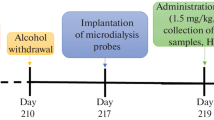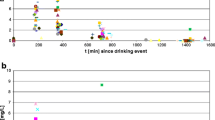Abstract
Based on the hypothesis of a relationship between the concentration of trace amines like tetrahydroisoquinolines (TIQ's) and β-carbolines (BC's) in the brain and an increased voluntary ingestion of ethanol, the concentrations of ethanol, acetaldehyde and harman (a β-carboline) were examined in a group of 20 alcoholics. The patients excreted a higher amount of harman into the urine than non-alcoholics on the day of admission (harman-1) as well as at the end of the detoxication period, 14 days later (harman-14). Certain factors were related to the increased excretion of harman by alcoholics: The younger the patient when he/she consumed ethanol for the first time, the higher the concentration of acetaldehyde in the blood and the amount of harman (harman-14) excreted in the urine. Furthermore, the younger the patient when he/she was intoxicated with ethanol for the first time the higher the amount of harman (harman-14) in the urine. Patients with first grade relatives who were alcoholics excreted more harman (harman-14) than those without such relatives. The following variables were not related to harman-14: The average amount of ethanol consumed daily during the 6 months prior to admission, the presence of signs of intoxication and symptoms of withdrawal at admission to hospital, and the consumption of other psychotropic substances. A negative correlation was found between the state of the liver, as assessed by liver histology and γ-glutamate transferase (γ-GT) levels, and the concentration of harman in the urine. Thus, some events in the patient's history as well as the state of the liver are important for the increased excretion of harman into urine of alcoholics.
Similar content being viewed by others
References
Airaksinen MM, Mähönen M, Tuomisto L, Peura P, Eriksson CJP (1983) Tetrahydro-β-carbolines: effect of alcohol intake in rats. Pharmacol Biochem Behav 18 Suppl 1:525–529
Allen JRF, Beck O, Borg S, Skroeder R (1980) Analysis of 1-methyl-1,2,3,4-tetrahydro-β-carboline in human urine and cerebrospinal fluid by gas chromatography — mass spectrometry. Eur J Mass Spectrom Biochem Med Envir Res 1:171–177
Bidder TG, Shoemaker DW, Boettger HG, Evans M, Cummins JT (1979) Harman in human platelets. Life Sci 25:157–164
Bortz I (1977) Lehrbuch der Statistik, Springer, Berlin-Heidelberg-New York
Collins MA (1980) Neuroamine condensations in human subjects. In: Begleiter H (ed) Biological effects of alcohol, Plenum Publ Corp, pp 87–102
Eriksson CJP (1980) Problems and pitfalls in acetaldehyde determination. Alcoholism: Clin Exp Res 4:22–29
Eriksson CJP (1983) Human blood acetaldehyde concentration during ethanol oxidation (update 1982). Pharmacol Biochem Behav 18:Suppl 1:141–150
Goodwin DW (1981) Genetic components of alcoholism. Ann Rev Med 32:93–99
Harada S, Agarwal DP, Gvedde HW (1978) Isozyme variations in acetaldehyde dehydrogenase (E.C. 1.2.1.2) in human tissues. Hum Genet 44:181–185
Jellinek EM (1960) The disease concept of alcoholism. Hillhouse Press, New Haven, pp 31–38
Jenkins WJ, Peters TJ (1980) Selectively reduced hepatic acetaldehyde dehydrogenase in alcoholics. Lancet 628–629
Lelbach WK (1967) Leberschäden bei chronischem Alkoholismus Teil III, bioptisch-histologische Ergebnisse. Acta hepato-gastroenterol (Stuttgart) 14:9–39
Lindros KO (1982) Human blood acetaldehyde levels: with improved methods, a clearer picture emerges. Alcoholism: Clin Exp Res 6:70–75
Melchior CL, Collins MA (1982) The routes and significance of endogenous synthesis of alkaloids in mammals. CRC Crit Rev Toxicol 9:313–356
Myers RD, Melchior CL (1977) Alcohol drinking: abnormal intake caused by tetrahydropapaveroline in the brain. Science 196:554–556
Rommelspacher H, Strauß S, Lindemann J (1980) Excretion of tetrahydroharmane and harmane into the urine of man and rat after a load with ethanol. FEBS Lett 109:209–212
Rommelspacher H, Brüning G (1984) Formation and function of tetrahydro-\-carbolines with special reference to their action on 3H tryptamine binding sites. In: Schlossberger HG, Kochen W, Linzen B, Steinhart H (eds) Progress in tryptophan and serotonin research, de Gruyter, Berlin, New York, pp 209–216
Rommelspacher H, Damm H, Strauß S, Schmidt G (1984) Ethanol induces an increase of harman in the brain and urine of rats. Naunyn Schmiedeberg's Arch Pharmacol 327:107–113
Sjöquist BS, Wallin A, Ljungquist (1984) on the origin of salsolinol. Second Congr Int Soc Biomed Res Alcoholism Abstr 243
Tuomisto L, Airaksinen MM, Peura P, Eriksson CJP (1982) Alcohol drinking in the rat: Increase following intracerebroventricular treatment with tetrahydro-β-carbolines. Pharmacol Biochem Behav 17:831–836
von Wartburg JP, Bühler R, Maring J-A, Pestalozzi D (1982) The polymorphismus of alcohol and aldehyde dehydrogenase and their significance for acetaldehyde toxicity. First Cong Int Soc Biomed Res Alcoholism
Author information
Authors and Affiliations
Additional information
Dedicated to Professor Helmut Kewitz at the occasion of his 65th birthday
Rights and permissions
About this article
Cite this article
Rommelspacher, H., Damm, H., Schmidt, L. et al. Increased excretion of harman by alcoholics depends on events of their life history and the state of the liver. Psychopharmacology 87, 64–68 (1985). https://doi.org/10.1007/BF00431780
Received:
Accepted:
Issue Date:
DOI: https://doi.org/10.1007/BF00431780




